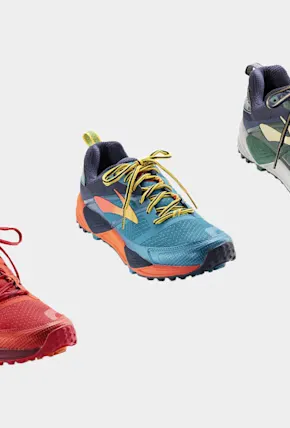How to Layer Women’s Hiking Apparel
Wherever you’re hiking, you’ll want to wear well-made, flexible women's hiking pants that will protect legs from the sun and obstacles on the trail, including branches, sticks, rocks, bugs and more. Opt for either a hiking pant (which often feature pockets and an adjustable waistband, a huge plus) or if you’re really into leggings, make sure the pair you pick are designed for hiking, durable enough to handle the rigors of the trail, and moisture wicking. The best hiking pants and hiking leggings will be fitted with mobility-minded features. Some popular styles include the Outdoor Research Ferrosi, the Arc'teryx Gamma and Patagonia Quandary Pants.
You’ll want to wear a baselayer as well, and while it needs to be moisture wicking regardless of the material, there are a few options you can choose from here: if you’re into natural fibers, opt for wool—merino or alpacka are my favorites. If you’d rather throw on a synthetic layer, make sure it’s UPF rated and breathable. Sun shirts in the summer are acceptable as a baselayer swap and encouraged, since most have a hood that will protect your neck and scalp from the sun’s rays. Whether you're in winter hiking clothes or summer-minded attire, moisture wicking is key when it comes to baselayers.
After baselayers, you’ll want to consider a midlayer. Most midlayers are fleece or fleece-like, and don’t typically feature waterproof or even water-resistant materials, although there are some that do, in case you’d really like that. Midlayers are meant to be worn in, well, the middle of your layering system, and so water-resistance isn’t crucial with these garments. Just make sure yours can dump heat, is comfortable, and can fit under your rain shell or warmer jacket. Which brings us to our next layer: outerwear.
If you’re going to be hiking warm, wet trails, a rain jacket will suffice as your outerwear. If you’re on a winter hike or hiking anywhere chilly or potentially chilly, lightweight hiking jackets for women are a must. You should opt for a jacket that is warm, waterproof and packable. Synthetic materials and insulation will be your friends in wetter environments, while down insulation is fine if you’re in cold, dry climes. It's important for a good experience hiking to make sure you're prepared for the environment you're trekking in. Brands we'd recommend for quality hiking clothes and daypacks for hiking include Mountain Hardwear, Outdoor Research, Patagonia, and Arc'teryx, among others.

Photo courtesy of Linnea Bullion
How to Care For and Maintain Hiking Apparel
Once you’ve purchased the women’s hiking apparel and outdoor gear that suits your needs and requirements, you’ll want to take proper care of it to preserve its quality for as long as possible. These tips apply to the best hiking shorts, your hiking backpack, the best women's hiking pants, your shoes and any other gear you're using to recreate. Here are a few of our top tips:
- Whether it’s made of synthetic or natural fibers, wash your hiking apparel on a delicate cycle at a low temperature, and fasten all buckles, zippers or fixtures before washing.
- If you must tumble-dry, do it on low. If you can air-dry, do so and lay your hiking clothes flat to dry, away from direct sunlight.
- Regularly waterproof your clothes with Nikwax or other re-impregnating solutions to preserve their efficacy.
- Store clothes in a cool, dry place where moths and other fabric-eating insects can’t access them.
- Wipe down any leather on boots and shoes with a damp, warm cloth.
- If you manage to rip a hole in your jacket or pants, repair it with a patch.
Whether you’re hiking in the depths of winter, the scorching heat or summer or somewhere in-between, remember to choose your fabrics carefully, layer appropriately, and take care of your gear once your hike is over. Happy trails!
Frequently Asked Questions
Why do women need specific hiking clothes?
Women’s bodies adapt to heat differently than men’s bodies, and research has shown that women tend to get colder easier than men. Women’s hiking apparel should be moisture wicking, supportive and capable of keeping extremities warm while letting heat out from high-temp areas like the lower back.
How do you choose the right hiking pants or leggings for hiking?
Whether you opt for traditional pants or leggings, make sure the pair you choose are comfortable, durable and moisture wicking. Avoid cotton, and look for options that are made from breathable, moisture-wicking natural materials like wool, or synthetic materials like nylon and spandex.
What is the best fabric for hiking in cold weather?
The best fabric for hiking in cold weather is fabric that is warm, moisture wicking and quick-drying. If you’re into synthetic materials, Polartec or any nylon/spandex blend will be appropriate. If you prefer natural materials, merino wool is the gold standard for cold weather hiking.
How important is breathability in hiking clothes for women?
Breathability is crucial for any outdoor activity or adventurer, but is especially important for fabrics that are waterproof, which tend to trap heat, or for any layers that will be worn in warm, wet environments. For women, breathability is key in baselayers and midlayers, due to their physiology.











